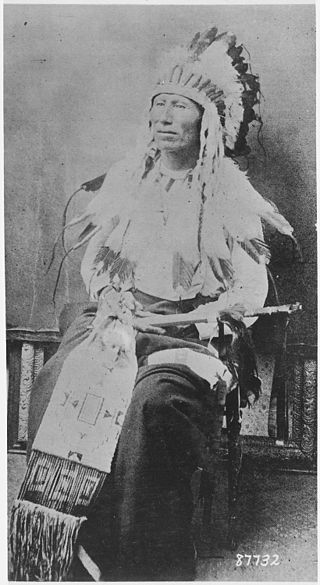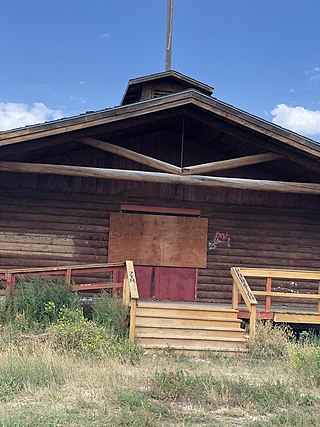
The Lakota are a Native American people. Also known as the Teton Sioux, they are one of the three prominent subcultures of the Sioux people, with the Eastern Dakota (Santee) and Western Dakota (Wičhíyena). Their current lands are in North and South Dakota. They speak Lakȟótiyapi—the Lakota language, the westernmost of three closely related languages that belong to the Siouan language family.

The Pine Ridge Indian Reservation, also called Pine Ridge Agency, is an Oglala Lakota Indian reservation located almost entirely within the U.S. state of South Dakota, with a small portion in Nebraska. Originally included within the territory of the Great Sioux Reservation, Pine Ridge was created by the Act of March 2, 1889, 25 Stat. 888. in the southwest corner of South Dakota on the Nebraska border. Today it consists of 3,468.85 sq mi (8,984 km2) of land area and is one of the largest reservations in the United States.

Whiteclay is a census-designated place in Sheridan County, Nebraska, United States. The population was 10 at the 2010 census.

Russell Charles Means was an Oglala Lakota activist for the rights of Native Americans, libertarian political activist, actor, musician and writer. He became a prominent member of the American Indian Movement (AIM) after joining the organization in 1968 and helped organize notable events that attracted national and international media coverage.

Morning Star (1810–1883) was a great chief of the Northern Cheyenne people and headchief of the Notameohmésêhese band on the northern Great Plains during the 19th century. He was noted for his active resistance to westward expansion and the United States federal government. It is due to the courage and determination of Morning Star and other leaders that the Northern Cheyenne still possess a homeland in their traditional country in present-day Montana.

Annie Mae Aquash was a First Nations activist and Mi'kmaq tribal member from Nova Scotia, Canada. Aquash moved to Boston in the 1960s and joined other First Nations and Indigenous Americans focused on education and resistance, and police brutality against urban Indigenous peoples. She was part of the American Indian Movement, participated in several occupations, and participated in the 1973 Wounded Knee incident at the Pine Ridge Indian Reservation, United States.
Nebraskans For Peace, or NFP, is a peace advocacy organization based in Lincoln, Nebraska, United States. "Nebraskans for Peace is a statewide grassroots advocacy organization working nonviolently for peace with justice through community building, education and political action."
Michael John Murphy is a folk musician based in Omaha, Nebraska. He plays various instruments, including the guitar, piano, and Native American flute. He has been a singer songwriter based out of Omaha since the 1970s.
Cecilia Fire Thunder is a nurse, community health planner and tribal leader of the Oglala Sioux. On November 2, 2004, she was the first woman elected as president of the Tribe. She served until being impeached on June 29, 2006, several months short of the two-year term. The major controversy was over her effort to build a Planned Parenthood clinic on the reservation after the South Dakota legislature banned most abortions throughout the state. The tribal council impeached her for proceeding without gaining their consensus.

The Wounded Knee Occupation, also known as Second Wounded Knee, began on February 27, 1973, when approximately 200 Oglala Lakota and followers of the American Indian Movement (AIM) seized and occupied the town of Wounded Knee, South Dakota, United States, on the Pine Ridge Indian Reservation. The protest followed the failure of an effort of the Oglala Sioux Civil Rights Organization (OSCRO) to use impeachment to remove tribal president Richard Wilson, whom they accused of corruption and abuse of opponents. Additionally, protesters criticized the United States government's failure to fulfill treaties with Native American people and demanded the reopening of treaty negotiations to hopefully arrive at fair and equitable treatment of Native Americans.
Richard A. Wilson was elected chairman of the Oglala Lakota of the Pine Ridge Indian Reservation in South Dakota, where he served from 1972–1976, following re-election in 1974.

Skins is a 2002 American feature film by Chris Eyre and based upon the novel of the same name by Adrian C. Louis. It was filmed on South Dakota's Pine Ridge Indian Reservation, which served as the setting in the novel. Lakota Sioux tribal police officer Rudy Yellow Lodge struggles to rescue his older, alcoholic brother, Mogie, a former football star who was wounded in combat three times in Vietnam. Winona LaDuke makes a cameo appearance as Rose Two Buffalo.

Native American tribes in the U.S. state of Nebraska have been Plains Indians, descendants of succeeding cultures of indigenous peoples who have occupied the area for thousands of years. More than 15 historic tribes have been identified as having lived in, hunted in, or otherwise occupied territory within the current state boundaries.

Yellow Bear, Mato Ǧí, was an Oglala Lakota leader.
Raymond Yellow Thunder was an Oglala Lakota, born in Kyle, South Dakota, on the Pine Ridge Indian Reservation.
Border effects refer to asymmetries in trade patterns between cities and regions of different countries and those that are located in the same country. Usually, trade volume between the former is much less. Economic integration may be a solution to overcome these effects. A 2017 meta-analysis of 1,271 estimates of the border effect finds that borders reduce trade by one third.
Franklin Dean LaMere was an American activist and politician. He was a member of the Winnebago Tribe of Nebraska from South Sioux City, and the son of a Gold Star Mother and a combat veteran father. He was a member of the American Indian Movement (AIM) in the 1970s and was noted for his work opposing liquor sales in Whiteclay, Nebraska, a small town whose main industry is selling alcohol to residents of the nearby Pine Ridge Indian Reservation, where alcohol sales are prohibited. LaMere was a leader in the Democratic Party, and served as chairman of the National Native American Caucus. He was a delegate to the Democratic National Convention seven consecutive times from 1988 to 2012.

The Lakota Nation Invitational is an annual multi-sport event tournament held each winter that began in 1976. The event takes place in the Rushmore Plaza Civic Center in Rapid City and hosts around 40 different schools from Indian Reservations in South Dakota, North Dakota, Nebraska and Wyoming. The event has categories including basketball, traditional Lakota hand games, knowledge and language bowls, a student art show, a business plan competition, wrestling, volleyball, cross country, archery, golf and a chess tournament
Paul Ignatius Manhart, S.J. was ordained a Jesuit priest of the Roman Catholic Church and served in various capacities on the Pine Ridge Indian Reservation in the Roman Catholic Diocese of Rapid City. His entire priestly career was dedicated to ministering among the Oglala Lakota Native Americans. Fr. Manhart’s scholarly work in linguistics helped preserve and disseminate the living, native North American Lakota language. He was a firsthand witness and participant in the Wounded Knee incident of 1973.
Bryan V. Brewer was president of the Oglala Sioux Tribe from 2012 to 2014.











